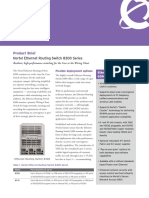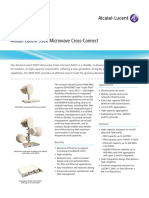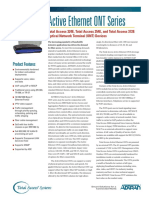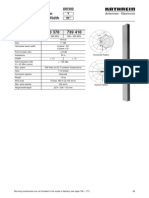Alcatel-Lucent 9500 MPR PDF
Alcatel-Lucent 9500 MPR PDF
Uploaded by
PavelKuzovkinCopyright:
Available Formats
Alcatel-Lucent 9500 MPR PDF
Alcatel-Lucent 9500 MPR PDF
Uploaded by
PavelKuzovkinOriginal Title
Copyright
Available Formats
Share this document
Did you find this document useful?
Is this content inappropriate?
Copyright:
Available Formats
Alcatel-Lucent 9500 MPR PDF
Alcatel-Lucent 9500 MPR PDF
Uploaded by
PavelKuzovkinCopyright:
Available Formats
Alcatel-Lucent 9500 MPR
MICROWAV E PACK E T R A DIO | RELEASE 3 ETSI
The Alcatel-Lucent 9500 Microwave Packet Radio (MPR) platform enables the smooth transformation of
transport networks from circuit to IP backhaul, thus seamlessly transporting TDM, ATM, IP and Ethernet over
a Carrier Ethernet infrastructure. As a result, the Alcatel-Lucent 9500 MPR efficiently transports multimedia
traffic while guaranteeing the Quality of Service (QoS) that end users require.
The Alcatel-Lucent 9500 MPR packet radio addresses all microwave applications with a single product family
from full outdoor to split-mount and nodal configurations for hybrid and full-packet traffic, thereby enabling
the easy introduction of full IP base-stations such as Long Term Evolution (LTE) while leveraging the existing
infrastructure. The operator is now free to maintain its current mode of operation using the TDM/hybrid
model, and can start to migrate to packet as data traffic grows (boosted as well by IP-3G nodeBs and HSPA
where needed). Mobile service providers, private operators and carriers now have a new platform, adding
exceptional functionality to their networks.
Features Radio throughput greater than 4 Gb/s
and termination of up to 192 x E1
Intelligent nodal IDU that supports up SDH transport, up to 8 STM1 interfaces
to 12 ODUs in hybrid or packet node EoS GFP mapping according to
Hitless switching service-driven ITU-T G.7041
Microwave Service Switch-8 (MSS-8)
adaptive modulation Ethernet OAM 802.3ag
Multiservice aggregator with Support of Synchronous Ethernet
embedded Circuit Emulation Service (SyncE) +SSM
(CES) (MEF 8) and ATM IMA pseudo
Support of LAG:
Microwave Service Switch-4 (MSS-4) wire (PWE3) (RFC 4717) capabilities
for Carrier Ethernet transport radio link (NNI)
Common multipurpose ODU for Ethernet user interfaces (UNI)
standalone full outdoor application Up to 2G Ethernet throughput
and split-mount and nodal over four channels
Microwave Service Switch-1c (MSS-1c)
configurations; XPIC upgradable Support of XPIC configurations:
Millimeter wave support Up to 1G Ethernet throughput on
MPT XPIC upgradable for very 56-MHz channel
high capacity
Multiservice switching capacity
Microwave Packet Transport (MPT): greater than 16 Gb/s
Multipurpose Outdoor Unit (ODU)
Benefits Native TDM-like performances (SAM) for the Alcatel-Lucent
Guarantees high-priority traffic IP/MPLS Service Router portfolio
Reduces OPEX transport even in congested nodes and the Alcatel-Lucent 1350 Optical
Aggregation of multiple access Simplified deployment Management System (OMS),
technologies over Ethernet conver for the Alcatel-Lucent T-MPLS/
Fast pre-provisioning
gence layer, removing the need of MPLS-TP Packet Optical Transport
Quick setup and network planning portfolio
new external equipment
Drastically reduces footprint and Enhanced performance and reliability
Protects operators investments
rack power dissipation with built-in test functionalities
and enables backhaul networks for
smooth migration from TDM to IP Highest nodal capability with Embedded synchronization distribution
smallest footprint (even in full Ethernet infrastructure)
Operates in hybrid (Ethernet/PDH/
SDH) or packet mode with the Zero footprint in standalone Nodal microwave configuration with
same hardware items full-outdoor solution to address a single packet matrix switching
full IP sites such as IP 3G, LTE or IP
Addresses all microwave applications Full redundancy with no single point
DSLAM backhaul; common system
with common hardware of failure, including Ethernet matrix
used in the split-mount solution
Backward compatibility with switch
Improves scalability and availability
existing hybrid ODU
End-to-end service-aware man-
Guarantees TDM deterministic
agement provided by the Alcatel-
behavior for packet transport
Lucent 5620 Service Aware Manager
Technical specifications Synchronization Express repair and return, swap Network and element
Any synchronization solutions and repair, and spare parts management
in hybrid and packet mode management Integrated network management
Applications (performances according to On-site visits, urgent interventions, in Windows environment
Hybrid and packet operational G.813/ G. 823/ G.8264) and technical assistance Embedded Web browser for NE
mode Clock distribution options Training from theory to installation supervision
Standalone full outdoor solution E1/STM-1 Alcatel-Lucent University Software-based configuration by PC
Mobile backhaul (Super PDH, External reference sync-in/ Customer premises Intuitive supervision systems
ATM and Ethernet aggregation) sync-out (2 MHz, 5 MHz, 10 MHz) Bundled services during warranty SNMP agent with TCP/IP rerouting
Full Ethernet/IP backhaul (IP 3G, Synchronous Ethernet (Sync E) period and warranty extensions capability
LTE, WiMAX, IP-DSLAM) + SSM G.8264 Interoperable with all Alcatel-
Fixed and private networks Built-in Stratum 3 clock Standards compliance Lucent wireless microwave and
STM-1 line clock EMC: EN 55022 Class B, transmission equipment
User interfaces EN 301 489-1/EN 301 489-4 Alcatel-Lucent 1350 OMS
Line clock recovery
32-port E1 Safety: EN 60950-1 Alcatel-Lucent 5620 SAM
ACR, DCR, node timing
2E1 port SFP module Ecological: ECMA TR/70
16-port E1 Any Service, Any Dimensions and weight Temperature Traffic management and QoS
Port (ASAP) Marking based on:
IDU (rack, desk or wall-mount) IDU: -40C to +65C
Embedded 4 x GE electrical (-40F to +149F) Layer 2 (802.1p)
and 2 x GE electrical/optical MSS-8 (2 RU)
MSS-4 (1 RU) ODU: -33C to +55C Layer 3 (DiffServ)
on SFP
(-27F to +131F)
8 x GE ports card MSS-4F (1RU)
IEEE 802.1p/Q VLAN tagging Operating frequencies
Auxiliary card (2 x V11 64 kb/s MSS-1c (height: 1 RU;
width: 1/2 RU) IEEE 802.3 CSMA/CD Refer to Tables 1 and 2 for typical
service channels or V28; house-
keeping in/out) IEEE 802.3u 100BaseTX values for microwave packet trans-
Weight port and system frequencies
Native ATM IMA termination - Fully equipped: <6 kg (13.2 lb) IEEE 802.3x Flow Control
and ATM PWE3 generation IEEE 802.3z 1000BaseSX/LX
(IETF RFC 4717) - Basic configuration: 2.5 kg
(5.5 lb) IEEE 802.1d Bridging
MEF 8 circuit emulation for TDM
ODU IEEE 802.1ad link aggregation
E1 Carrier Ethernet transport
Weight: 5 kg (11 lb) average IEEE 802.1ag Ethernet OAM
2xSTM1 ports
1000BaseT per 802.3ab
EoSDH SFP module (G.7041)
Power supply MEF 9
E3 SFP module
Standard: -48 V DC to -60 V DC MEF 14
Indoor/outdoor connection Optional: -24 V DC to -60 V DC
Single coaxial cable for split-
mount configuration Services
Length: Up to 300m (984 ft) Network design and planning
GigE electrical or optical cable Hotline
Length: Up to 450 m
2 Alcatel-Lucent 9500 MPR | Release 3 | Data Sheet
Table 1. Microwave Packet Transport radio-frequency specifications: Typical values
System
L6/U6 GHz 7 GHz 8 GHz 10 GHz 11 GHz 13 GHz 15 GHz 18 GHz 23 GHz 26 GHz 28 GHz 32 GHz 38 GHz 80 GHz
Frequency 5.925 to 6.425 7.125 to 7.725 to 10.15 to 10.7 to 12.75 to 14.4 to 17.7 to 21.2 to 24.52 to 27.5 to 31.8 to 37.0 to 71.250 to 75.750
range (GHz) 6.425 to 7.11 7.9 8.5 10.68 11.7 13.25 15.35 19.7 23.632 26.483 29.5 33.4 33.4 81.250 to 85.750
Power output, nominal (dBm)
L6/U6 GHz 7 GHz HP 8 GHz HP 10 GHz 11 GHz 13 GHz 15 GHz 18 GHz 23 GHz 26 GHz 28 GHz 32 GHz 38 GHz 80 GHz
BPSK 18.0
QPSK
QPSK 26.0 26.0 26.0 26.0 25.0 25.0 25.0 22.0 20.0 18.0 15.0 18.0 18.0
8PSK
16-QAM 25.0 25.0 25.0 24.0 23.0 23.0 23.0 20.0 19.0 16.0 13.0 16.0 16.0
32-QAM
64-QAM 22.0 24.0 24.0 23.0 21.0 21.0 22.0 19.0 17.0 14.0 12.0 15.0 14.0
128-QAM
256-QAM 22.0 24.0 24.0 20.0 20.0 19.0 20.0 18.0 17.0 13.0 9.0 12.0 13.0
Table 2. System specifications: Typical values
System Gain CS L6 U6 7 GHz 8 GHz 10 GHz 11 GHz 13 GHz 15 GHz 18 GHz 23 GHz 26 GHz 28 GHz 32 GHz 38 GHz 80 GHz Capacity (Mb/s)
at 10-3 (dBm) (MHz) GHz GHz HP HP
Typical Maximum
QPSK 122.5 122.5 121.5 121.5 119.0 120.5 119.5 120.5 116.5 115.0 112.0 107.0 110.0 110.0 10 >15
16-QAM 7 116.0 116.0 115.0 115.0 110.0 113.0 112.5 113.0 109.0 108.5 104.5 98.0 100.5 102.5 20 >32
64-QAM 106.5 106.5 107.5 107.5 103.0 104.5 104.0 105.5 101.5 100.0 96.0 91.5 94.0 94.0 30 >47
QPSK 119.5 119.5 118.5 118.5 116.0 117.5 117.0 117.5 113.5 112.0 109.0 104.0 106.5 107.0 20 >32
16-QAM 14 113.5 113.5 112.5 112.5 108.0 110.5 109.5 110.5 106.5 106.0 102.0 94.5 97.5 100.0 40 >65
64-QAM 103.5 103.5 104.5 104.5 100.5 101.5 101.0 102.5 98.5 97.0 93.0 87.5 90.0 91.0 60 >98
QPSK 117.0 117.0 116.0 116.0 113.5 115.0 114.0 115.0 111.0 109.5 106.5 101.0 103.5 104.5 40 >68
16-QAM 110.0 110.0 109.0 109.0 105.5 107.0 107.0 107.0 103.0 102.5 98.5 92.0 94.5 96.5 80 >137
32-QAM 106.0 106.0 105.0 105.0 101.5 103.0 103.0 103.0 99.0 98.5 94.5 88.0 90.5 92.5 100 >168
28
64-QAM 100.5 101.5 101.5 101.5 97.5 98.5 98.0 99.5 95.5 94.0 90.0 84.5 87.0 88.0 125 >201
128-QAM 96.5 97.5 97.5 97.5 94.0 94.5 94.5 95.5 91.5 90.0 86.0 79.0 81.5 84.0 150 >237
256-QAM 93.5 93.5 94.5 94.5 89.0 90.5 89.5 90.5 87.5 87.0 82.0 74.0 76.5 80.0 180 >281
16-QAM 108.0 108.0 107.0 107.0 103.0 104.8 104.5 104.8 100.8 100.3 96.3 89.5 92.0 94.3 165 >252
128-QAM 56 94.5 95.5 95.5 95.5 89.5 92.0 92.0 93.0 89.0 87.5 83.5 74.5 77.0 81.5 300 >465
256-QAM 91.5 91.5 93.0 93.0 84.5 88.5 87.5 88.5 85.5 85.0 80.0 69.5 72.0 78.0 340 >530
System Gain CS L6/U6 L6/U6 7 GHz 8 GHz 10 GHz 11 GHz 13 GHz 15 GHz 18 GHz 23 GHz 26 GHz 28 GHz 32 GHz 38 GHz 80 GHz Capacity (Mb/s)
at 10-6 (MHz) GHz GHz
BPSK 91.0 >120
250
QPSK 88.0 >240
BPSK 84.0 >600
1000
QPSK 81.0 >1200
www.alcatel-lucent.com Alcatel, Lucent, Alcatel-Lucent and the Alcatel-Lucent logo
are trademarks of Alcatel-Lucent. All other trademarks are the property of their respective owners.
The information presented is subject to change without notice. Alcatel-Lucent assumes no responsibility
for inaccuracies contained herein. Copyright 2011 Alcatel-Lucent. All rights reserved.
CPG1076110314 (04)
You might also like
- Radio Spectrum Management: Policies, Regulations and TechniquesFrom EverandRadio Spectrum Management: Policies, Regulations and TechniquesNo ratings yet
- April 2010 9500 MPR R2 ETSI DSDocument4 pagesApril 2010 9500 MPR R2 ETSI DSMadeline CurryNo ratings yet
- Alcatel Lucent 9500 MPR Datenblatt Version 4Document4 pagesAlcatel Lucent 9500 MPR Datenblatt Version 4Madeline CurryNo ratings yet
- Alcatel-Lucent 9500 Microwave Packet Radio: North American Markets - Release 2Document5 pagesAlcatel-Lucent 9500 Microwave Packet Radio: North American Markets - Release 2Marcos AntunesNo ratings yet
- Siaemic ALS.l LeafletDocument2 pagesSiaemic ALS.l Leafletanon_919996401No ratings yet
- siaemic-ALS.l Leaflet PDFDocument2 pagessiaemic-ALS.l Leaflet PDFakmal abdNo ratings yet
- RTN 910+950+980Document6 pagesRTN 910+950+980glukkerNo ratings yet
- 8609 Smart Router Modular-Access-RouterDocument3 pages8609 Smart Router Modular-Access-RouterGisselle GranadaNo ratings yet
- Tejas Networks TJ1400-Ultra-ConvergedDocument4 pagesTejas Networks TJ1400-Ultra-ConvergedinvisiblebeamyNo ratings yet
- MP 2100Document10 pagesMP 2100Rogerio LimaNo ratings yet
- Aviat CTR 8540 Data SheetDocument2 pagesAviat CTR 8540 Data SheetMuhammed Rayis KalliyilNo ratings yet
- 9500 MPR r4-1 Etsi en DatasheetDocument4 pages9500 MPR r4-1 Etsi en DatasheetKonstantin GorbokonNo ratings yet
- MKT2014066260EN 9500 MPR ETSI Datasheet PDFDocument3 pagesMKT2014066260EN 9500 MPR ETSI Datasheet PDFyordan evertNo ratings yet
- Tejas Networks TJ1400-Ultra-ConvergedDocument4 pagesTejas Networks TJ1400-Ultra-ConvergedMuhammad AbdulfatahNo ratings yet
- Siaemic - Ags20.l LeafletDocument4 pagesSiaemic - Ags20.l LeafletErenilson_JesusNo ratings yet
- 7342 ISAM ONT I-010G-U DatasheetDocument2 pages7342 ISAM ONT I-010G-U Datasheeterda81776No ratings yet
- DS 8609 Smart Router 74C0022Document3 pagesDS 8609 Smart Router 74C0022Walisan turiNo ratings yet
- Nokia - 1830 - Optical - Network - Extender - Aggregator - Release - 4.2 - Data - Sheet - ENDocument3 pagesNokia - 1830 - Optical - Network - Extender - Aggregator - Release - 4.2 - Data - Sheet - ENmanhhaibcvtNo ratings yet
- Item 4c.i - Microwave AGS20 Series Datasheet (SIAE)Document6 pagesItem 4c.i - Microwave AGS20 Series Datasheet (SIAE)chee wy100% (1)
- Aviat CTR 8540 Data Sheet - April 26 - 2018Document2 pagesAviat CTR 8540 Data Sheet - April 26 - 2018Sulaiman HasanNo ratings yet
- Alcatel-Lucent 1626 Light Manager: Release 6.1Document3 pagesAlcatel-Lucent 1626 Light Manager: Release 6.1Peng HaoNo ratings yet
- OmniSwitch 6450-24-48 Datasheet enDocument10 pagesOmniSwitch 6450-24-48 Datasheet enrenuNo ratings yet
- RTN 900 Brochure (910&950) V2.0Document4 pagesRTN 900 Brochure (910&950) V2.0Juan Antonio GranadosNo ratings yet
- ALSseriesE 019Document4 pagesALSseriesE 019WilsonsbNo ratings yet
- Nortel Ethernet Routing Switch 8300 Series - Product BriefDocument6 pagesNortel Ethernet Routing Switch 8300 Series - Product BriefdklsfxNo ratings yet
- Annex 5.2.2 1850 - TSS-160 - R3-0 - DSDocument4 pagesAnnex 5.2.2 1850 - TSS-160 - R3-0 - DSswag lolNo ratings yet
- 9500 MXC R1-1-3 Data SheetDocument5 pages9500 MXC R1-1-3 Data SheetrmarikuNo ratings yet
- RBN - SDH MigrationDocument22 pagesRBN - SDH Migrationwejdanalsamawi57No ratings yet
- 1850 TSS-5C DatasheetDocument2 pages1850 TSS-5C DatasheetNguyen TrungNo ratings yet
- 9500 MXC DSDocument6 pages9500 MXC DSDAGNUXNo ratings yet
- DS 8605 Smart Router 74C0029Document2 pagesDS 8605 Smart Router 74C0029Walisan turiNo ratings yet
- Lentronics JunglePAX Brochure 31950B EN 202105Document12 pagesLentronics JunglePAX Brochure 31950B EN 202105Bruno MarceloNo ratings yet
- ALS Series: Microwave RadioDocument2 pagesALS Series: Microwave Radiodp46No ratings yet
- Alcatel Lucent 9412 eNodeB Compact PDFDocument2 pagesAlcatel Lucent 9412 eNodeB Compact PDFBijaya RanaNo ratings yet
- DS 8660 Smart Router 74C0026 PDFDocument3 pagesDS 8660 Smart Router 74C0026 PDFgarogonNo ratings yet
- Siaemic - AGS20 - Leaflet - October 2021Document4 pagesSiaemic - AGS20 - Leaflet - October 2021Miguel MendezNo ratings yet
- Hit 7300 BENEFITS OF CORIANT'S Multi-Haul PDFDocument3 pagesHit 7300 BENEFITS OF CORIANT'S Multi-Haul PDFTrương Thị LanNo ratings yet
- Siaemic - AGS20 - Leaflet - January 2024Document4 pagesSiaemic - AGS20 - Leaflet - January 2024Bilal WarraichNo ratings yet
- The DMT1000E Series: Advanced Compact Access Switches For Mobile Backhaul NetworksDocument2 pagesThe DMT1000E Series: Advanced Compact Access Switches For Mobile Backhaul NetworksnewalfNo ratings yet
- Alcatel-Lucent 9412 eNodeB CompactDocument2 pagesAlcatel-Lucent 9412 eNodeB Compactomauriciogal100% (2)
- AGS20 Leaflet and DatasheetDocument6 pagesAGS20 Leaflet and DatasheetLázaro VieiraNo ratings yet
- Infinera Mtera Universal Transport PlatformDocument2 pagesInfinera Mtera Universal Transport Platformrobert adamsNo ratings yet
- 9500 MPR Ansi en Datasheet 3.3Document17 pages9500 MPR Ansi en Datasheet 3.3ysussyNo ratings yet
- Datasheet SLF PDFDocument2 pagesDatasheet SLF PDFTERASAT SANo ratings yet
- Transport XWDM Packet-Optical-Transport 7100 PicoDocument3 pagesTransport XWDM Packet-Optical-Transport 7100 PicoEduardo MagossiNo ratings yet
- Alcatel 7342 Isam OltDocument4 pagesAlcatel 7342 Isam Oltpantod2002100% (2)
- High Capacity Optical Transport Platform: DatasheetDocument3 pagesHigh Capacity Optical Transport Platform: DatasheetWalisan turiNo ratings yet
- 3960 Service Delivery Switch DSDocument5 pages3960 Service Delivery Switch DSPeterNo ratings yet
- Alu SDH 1660Document3 pagesAlu SDH 1660DAGNUXNo ratings yet
- Aviat CTR 8540 Data SheetDocument2 pagesAviat CTR 8540 Data Sheetsanosuke_samaNo ratings yet
- Active Ethernet ONT Series: Product FeaturesDocument4 pagesActive Ethernet ONT Series: Product FeaturesKgs Irwan JunaidiNo ratings yet
- Service Delivery Switch: Data SheetDocument6 pagesService Delivery Switch: Data Sheetsatyvan2003No ratings yet
- DS 8660 Smart Router 74C0026Document3 pagesDS 8660 Smart Router 74C0026Walisan turiNo ratings yet
- Manual SIAEDocument4 pagesManual SIAEAlexander Brito VillaNo ratings yet
- Concise Guide to OTN optical transport networksFrom EverandConcise Guide to OTN optical transport networksRating: 4 out of 5 stars4/5 (2)
- GSM, GPRS and EDGE Performance: Evolution Towards 3G/UMTSFrom EverandGSM, GPRS and EDGE Performance: Evolution Towards 3G/UMTSTimo HalonenNo ratings yet
- CompTIA Network+ (N10-009) Study Guide: Comprehensive Exam Preparation and Key Concepts for Network ProfessionalsFrom EverandCompTIA Network+ (N10-009) Study Guide: Comprehensive Exam Preparation and Key Concepts for Network ProfessionalsNo ratings yet
- Cisco Certified Network Associate (CCNA) and Cisco Certified Network Professional (CCNP): Mastering Network Automation and Programmability Study GuideFrom EverandCisco Certified Network Associate (CCNA) and Cisco Certified Network Professional (CCNP): Mastering Network Automation and Programmability Study GuideNo ratings yet
- FHELDocument5 pagesFHELPavelKuzovkin100% (3)
- TP48200A-D12A1 Quick Installation Guide V300R001 01 PDFDocument2 pagesTP48200A-D12A1 Quick Installation Guide V300R001 01 PDFPavelKuzovkinNo ratings yet
- Flexi Fibre FSFBDocument1 pageFlexi Fibre FSFBPavelKuzovkinNo ratings yet
- May 2011 9500 MPR Etsi r3 en DatasheetDocument3 pagesMay 2011 9500 MPR Etsi r3 en DatasheetmghjghjghNo ratings yet
- Allgon UXM-65-90 - 7701Document5 pagesAllgon UXM-65-90 - 7701PavelKuzovkinNo ratings yet
- RFS APXV9RxxBDocument2 pagesRFS APXV9RxxBPavelKuzovkinNo ratings yet
- Eltek-2 Outdoor Instal GuideDocument20 pagesEltek-2 Outdoor Instal GuidePavelKuzovkin100% (1)
- PowerWave 7233.04Document2 pagesPowerWave 7233.04PavelKuzovkinNo ratings yet
- RFS Apxv9r13b-C-A20Document2 pagesRFS Apxv9r13b-C-A20PavelKuzovkin0% (1)
- Kathrein 800 10426Document2 pagesKathrein 800 10426PavelKuzovkinNo ratings yet
- Tongyu TDQ-172718DE-65FDocument1 pageTongyu TDQ-172718DE-65FPavelKuzovkinNo ratings yet
- Allgon 9215.01Document1 pageAllgon 9215.01PavelKuzovkinNo ratings yet
- Kathrein 732 690Document2 pagesKathrein 732 690PavelKuzovkinNo ratings yet
- Kathrein 730 378Document1 pageKathrein 730 378PavelKuzovkinNo ratings yet
- Comba CM-DW2-ODxxDocument1 pageComba CM-DW2-ODxxPavelKuzovkinNo ratings yet
- Comba CM-KY2-OD4BDocument1 pageComba CM-KY2-OD4BPavelKuzovkinNo ratings yet
- Comba CM-KY2-OD4BDocument1 pageComba CM-KY2-OD4BPavelKuzovkinNo ratings yet











































































